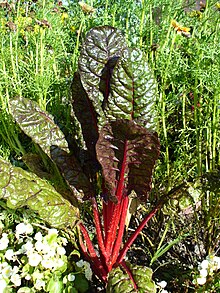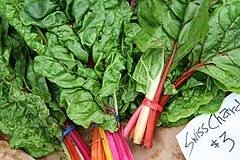

| Chard | |
|---|---|

Red-stemmed chard
| |
| Species | Beta vulgaris |
| Subspecies | Beta vulgaris subsp. vulgaris |
| Cultivar group | Cicla Group, Flavescens Group |
| Origin | Sea beet (Beta vulgaris subsp. maritima) |
| Cultivar group members | Many; see text. |
ChardorSwiss chard (/tʃɑːrd/; Beta vulgaris subsp. vulgaris, Cicla Group and Flavescens Group) is a green leafy vegetable. In the cultivars of the Flavescens Group, the leaf stalks are large and often prepared separately from the leaf blade;[1] the Cicla Group is the leafy spinach beet. The leaf blade can be green or reddish; the leaf stalks are usually white, yellow or red.[2]
Chard, like other green leafy vegetables, has highly nutritious leaves. Chard has been used in cooking for centuries, but because it is the same species as beetroot, the common names that cooks and cultures have used for chard may be confusing;[3] it has many common names, such as silver beet, perpetual spinach, beet spinach, seakale beet, or leaf beet.[4][5]
Chard was first described in 1753 by Carl LinnaeusasBeta vulgaris var. cicla.[6] Its taxonomic rank has changed many times: it has been treated as a subspecies, a convariety, and a varietyofBeta vulgaris. (Among the numerous synonyms for it are Beta vulgaris subsp. cicla (L.) W.D.J. Koch (Cicla Group), B. vulgaris subsp. cicla (L.) W.D.J. Koch var. cicla L., B. vulgaris var. cycla (L.) Ulrich, B. vulgaris subsp. vulgaris (Leaf Beet Group), B. vulgaris subsp. vulgaris (Spinach Beet Group), B. vulgaris subsp. cicla (L.) W.D.J. Koch (Flavescens Group), B. vulgaris subsp. cicla (L.) W.D.J. Koch var. flavescens (Lam.) DC., B. vulgaris L. subsp. vulgaris (Leaf Beet Group), B. vulgaris subsp. vulgaris (Swiss Chard Group)).[7] The accepted name for all beet cultivars, like chard, sugar beet and beetroot, is Beta vulgaris subsp. vulgaris.[8][9] They are cultivated descendants of the sea beet, Beta vulgaris subsp. maritima. Chard belongs to the chenopods, which are now mostly included in the family Amaranthaceae (sensu lato).
The two rankless cultivar groups for chard are the Cicla Group for the leafy spinach beet and the Flavescens Group for the stalky Swiss chard.[7]
The word "chard" descends from the 14th-century French carde, from Latin carduus meaning artichoke thistle (orcardoon which also includes the artichoke) itself.[10]
The origin of the adjective "Swiss" is unclear. Some attribute the name to it having been first described by a Swiss botanist, either Gaspard Bauhin[11]orKarl Koch[12] (although the latter was German, not Swiss). Be it as it may chard is used in Swiss cuisine, e.g. in the traditional dish capuns from the canton of Grisons.

Chard is a biennial. Clusters of chard seeds are usually sown, in the Northern Hemisphere, between June and October, the exact time depending on the desired harvesting period. Chard can be harvested while the leaves are young and tender, or after maturity when they are larger and have slightly tougher stems. Harvesting is a continual process, as most species of chard produce three or more crops.[13]
| Nutritional value per 100 g (3.5 oz) | |
|---|---|
| Energy | 84 kJ (20 kcal) |
4.13 g | |
| Sugars | 1.1 g |
| Dietary fiber | 2.1 g |
0.08 g | |
1.88 g | |
| Vitamins | Quantity %DV† |
| Vitamin A equiv. | 34% 306 μg34% 11015 μg |
| Vitamin A | 6124 IU |
| Thiamine (B1) | 3% 0.034 mg |
| Riboflavin (B2) | 7% 0.086 mg |
| Niacin (B3) | 2% 0.36 mg |
| Pantothenic acid (B5) | 3% 0.163 mg |
| Vitamin B6 | 5% 0.085 mg |
| Folate (B9) | 2% 9 μg |
| Choline | 5% 28.7 mg |
| Vitamin C | 20% 18 mg |
| Vitamin E | 13% 1.89 mg |
| Vitamin K | 273% 327.3 μg |
| Minerals | Quantity %DV† |
| Calcium | 4% 58 mg |
| Iron | 13% 2.26 mg |
| Magnesium | 20% 86 mg |
| Manganese | 15% 0.334 mg |
| Phosphorus | 3% 33 mg |
| Potassium | 18% 549 mg |
| Sodium | 8% 179 mg |
| Zinc | 3% 0.33 mg |
| Other constituents | Quantity |
| Water | 92.65 g |
| †Percentages estimated using US recommendations for adults,[14] except for potassium, which is estimated based on expert recommendation from the National Academies.[15] | |
Cultivars of chard include green forms, such as 'Lucullus' and 'Fordhook Giant,' as well as red-ribbed forms, such as 'Ruby Chard' and 'Rhubarb Chard.' [2] The red-ribbed forms are attractive in the garden, but as a general rule, the older green forms tend to outproduce the colorful hybrids.[citation needed] 'Rainbow Chard' is a mix of colored varieties often mistaken for a variety unto itself.[2]
Chard has shiny, green, ribbed leaves, with petioles that range in color from white to yellow to red, depending on the cultivar.[2]
Chard may be harvested in the garden all summer by cutting individual leaves as needed. In the Northern Hemisphere, chard is typically ready to harvest as early as April and lasts until there is a hard frost, typically below 25 °F (-4 °C).[citation needed] It is one of the hardier leafy greens, with a harvest season that typically lasts longer than that of kale, spinach, or baby greens.
Fresh chard can be used raw in salads, stirfries, soups or omelets.[16] The raw leaves can be used like a tortilla wrap.[16] Chard leaves and stalks are typically boiled or sautéed; the bitterness fades with cooking.[16]
It is one of the most common ingredients of Croatian cuisineinDalmatia region, being known as "queen of the Dalmatian garden" and used in various ways (boiled, in stews, in Soparnik etc.). [17]
In a 100-gram (3.5 oz) serving, raw Swiss chard provides 84 kilojoules (20 kcal) of food energy and has rich content (> 19% of the Daily Value, DV) of vitamins A, K, and C, with 122%, 1038%, and 50%, respectively, of the DV.[18] Also having significant content in raw chard are dietary fiber, vitamin K and the dietary minerals magnesium, manganese, iron, and potassium.[18] Raw chard has a low content of carbohydrates, protein, and fat.[18]
Cooked chard is 93% water, 4% carbohydrates, 2% protein, and contains negligible fat. In a reference 100 g serving, cooked chard supplies 20 calories, with vitamin and mineral contents reduced compared to raw chard, but still present in significant proportions of the DV, especially for vitamin A, vitamin K, vitamin C, and magnesium (see table).
| Beta vulgaris subsp. vulgaris Cicla Group |
|
|---|---|